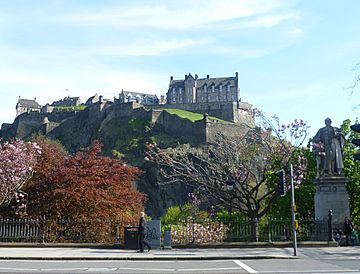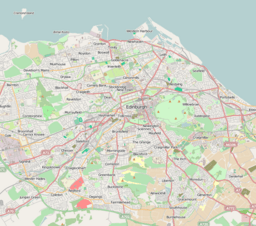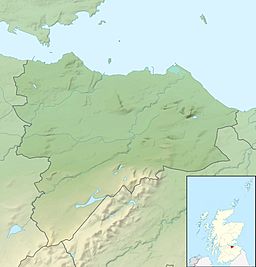Castle Rock (Edinburgh) facts for kids
Quick facts for kids Castle Rock |
|
|---|---|

Castle Rock as seen from Princes Street
|
|
| Highest point | |
| Elevation | 140 m (460 ft) |
| Prominence | c. 80 m (260 ft) |
| Listing | Tump |
| Geography | |
| Topo map | OS Landranger 66 |
| Geology | |
| Age of rock | ~350 million years |
| Mountain type | Crag and tail, volcanic plug |
| Climbing | |
| First ascent | Unknown |
Castle Rock is a famous rock in the heart of Edinburgh, Scotland. It is the ancient base upon which the historic Edinburgh Castle proudly stands. This amazing rock is what's left of an old volcano. It formed about 350 million years ago!
Contents
What is Castle Rock?
Castle Rock is known as a volcanic plug. Imagine a volcano that was once active. When it stopped erupting, the magma (hot, melted rock) inside its main pipe cooled down. This cooled rock became very hard. Over millions of years, the softer rocks around it wore away. This left behind the tough volcanic plug standing tall.
How Castle Rock Formed
The rock is made of a very strong type of rock called dolerite. This is like a tougher version of basalt, which you might know from other volcanoes. About 350 million years ago, during the early Carboniferous period, magma pushed up through the ground. It then cooled and hardened inside the volcano's pipe.
Later, huge sheets of ice, called glaciers, moved across the land. These glaciers scraped away the softer rocks. But the hard dolerite of Castle Rock was too strong to be easily moved. It protected the softer ground behind it, to the east. This process created a special shape called a crag and tail. The "crag" is the steep, rocky part (Castle Rock itself). The "tail" is the gentler slope of protected land behind it.
Why it's a Great Spot for a Castle
The top of Castle Rock is about 130 meters (426 feet) above sea level. It has steep, rocky cliffs on its south, west, and north sides. These cliffs rise up to 80 meters (262 feet) from the land around them. This means it's very hard to attack the castle from most directions.
The only easy way to reach the castle is from the east. This is where the "tail" of the crag and tail formation slopes more gently. This natural defense made Castle Rock a perfect place to build a strong castle. It was very difficult for enemies to reach.
Water Supply Challenges
Even though the rock was great for defense, it had one big problem: water. The hard volcanic rock (basalt and dolerite) does not hold water well. This meant it was hard to get enough water for the castle.
There was a deep well, about 28 meters (92 feet) deep, inside the castle. But during dry times or when the castle was under attack, the water often ran out. For example, during a long siege in 1573, getting enough water was a major challenge for the people inside Edinburgh Castle.




